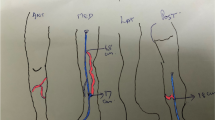Abstract
Doppler evaluation of lower limb veins was performed to evaluate the pattern of involvement of various sites of incompetence in Indian patients with varicose veins. A prospective Doppler study of 100 consecutive limbs in patients who presented with varicose veins to the vascular surgery department of a tertiary care hospital in India. The Clinico-Etiological Anatomical and Pathological (CEAP) classification was applied for assessment. Doppler evaluation of both superficial and deep venous system of the lower limbs was performed. The data of various sites of reflux was analysed to find the patterns of venous involvement in the affected patients. Superficial venous reflux was seen in all the patients. Deep venous reflux was seen in 50% of the lower limbs examined. Doppler is a simple non-invasive test, and is well tolerated by the patients. Deep venous reflux is common in Indian population, though it rarely occurs in isolation, and is usually associated with superficial reflux.


Similar content being viewed by others
References
Houghton AD, Panayiotopoulos Y, Taylor PR (1996) Practical management of primary varicose veins. Br J Clin Pract 50(2):103–105
Callam MJ (1994) Epidemiology of varicose veins. Br J Surg 81(2):167–173
Davy A (1983) Epidemiology of varicose veins. Phlebologie 36(1):23–28
Malhotra SL (1972) An epidemiological study of varicose veins in Indian railroad workers from the South and North of India, with special reference to the causation and prevention of varicose veins. Int J Epidemiol 1(2):177–183
Dixon PM (1996) Doppler ultrasound in the pre-operative assessment of varicose veins. Australas Radiol 40(4):416–421
Masuda EM, Kistner RL, Eklof B (1994) Prospective study of Doppler scanning for venous reflux: comparison of Valsalva and pneumatic cuff techniques in the reverse Trendelenburg and standing positions. J Vasc Surg 20(5):711–720
Jeanneret C, Labs KH (1999) Physiological reflux and venous diameter change in the proximal lower limb veins during a standardised Valsalva manoeuvre. Eur J Vasc Endovasc Surg 17(5):398–403
Cohen J (1991) Venous insufficiency and oral contraception. Rev Fr Gynecol Obstet 86(2 Pt 2):187–189
Evans CJ, Fowkes FG (1999) Prevalence of varicose veins and chronic venous insufficiency in men and women in the general population: Edinburgh Vein Study. J Epidemiol Community Health 53(3):149–153
Evans CJ, Allan PL, Lee AK et al (1998) Prevalence of venous reflux in the general population on Doppler scanning: the edinburgh vein study. J Vasc Surg 28:767–776
Ioannou CV, Giannoukas AD et al (2003) Patterns of venous reflux in limbs with venous ulcers. Implications for treatment. Int Angiol 22(2):182–187
Magnusson MB, Nelzen O, Risberg B, Sivertsson R (2001) A colour Doppler ultrasound study of venous reflux in patients with chronic leg ulcers. Eur J Vasc Endovasc Surg 21(4):353–360
Tassiopoulos AK, Golts E et al (2000) Eur J Vasc Endovasc Surg 20(3):227–232
Walsh JC, Bergan JJ, Beeman S, Comer T (1994) Femoral venous reflux abolished by greater saphenous vein stripping. Ann Vasc Surg 566–570.
Stuart WP, Adam DJ, Allan PL et al (2000) The relationship between the number, competence, and diameter of medial calf perforating veins and the clinical status in healthy subjects and patients with lower-limb venous disease. J Vasc Surg 32(1):138–143
Labropoulos N, Mansour MA et al (1999) New insights into perforator vein incompetence. Eur J Vasc Endovasc Surg 18(3):228–234
Author information
Authors and Affiliations
Corresponding author
Rights and permissions
About this article
Cite this article
Irodi, A., Keshava, S.N., Agarwal, S. et al. Ultrasound Doppler Evaluation of the Pattern of Involvement of Varicose Veins in Indian Patients. Indian J Surg 73, 125–130 (2011). https://doi.org/10.1007/s12262-010-0195-0
Received:
Accepted:
Published:
Issue Date:
DOI: https://doi.org/10.1007/s12262-010-0195-0




